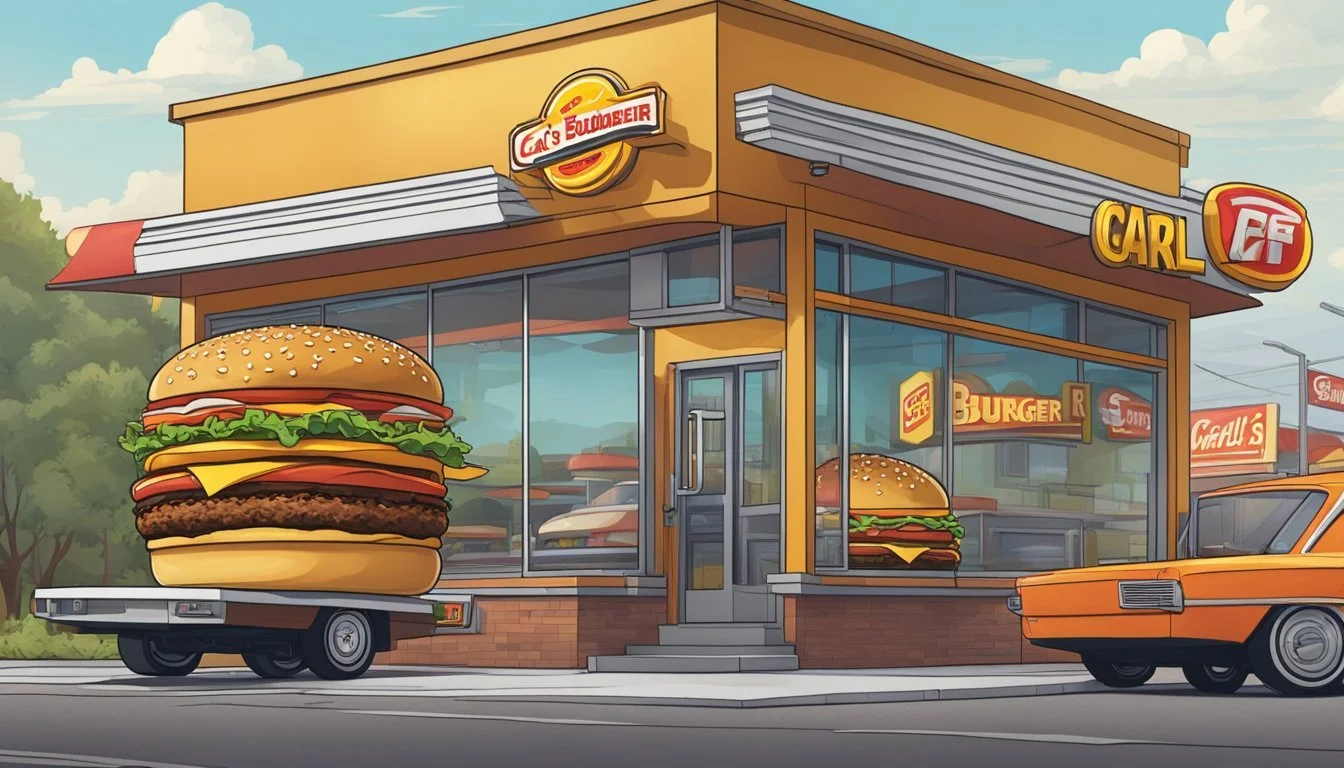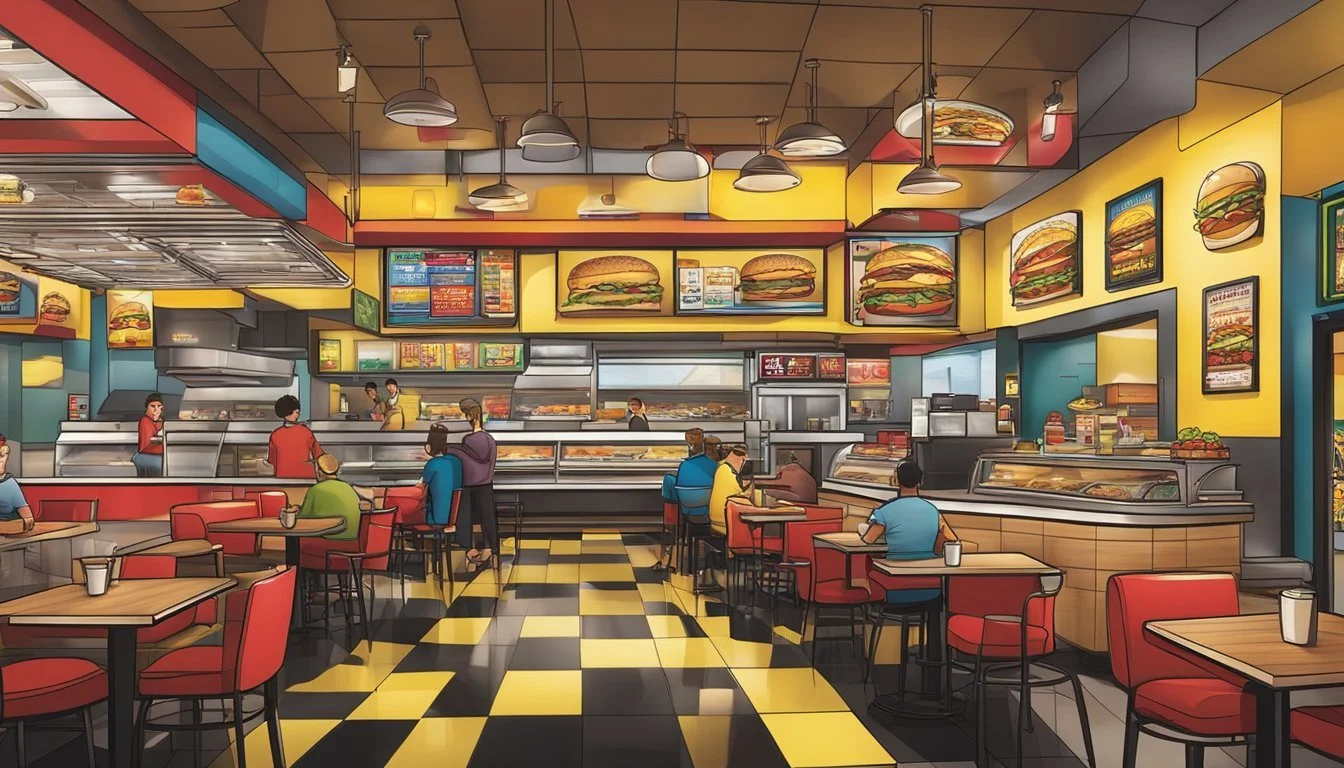Carl's Jr. vs Fatburger
The Ultimate Burger Showdown
When it comes to American fast food, the burger stands as an iconic symbol of this cuisine. Carl's Jr. and Fatburger have both carved out substantial niches within the burger domain, each presenting its unique approach to crafting the classic American sandwich. Carl's Jr. is known for its widespread brand presence and variability in menu options that cater to diverse diets, including gluten-free, vegan, and vegetarian needs.
Fatburger, on the other hand, prides itself on its title burger, the Fatburger, which is recognized for its lean beef and substantial toppings. While Carl's Jr. has built a reputation for convenience with support for various payment methods and discounts, Fatburger holds a special place in the hearts of West Coast burger enthusiasts with its commitment to classic burger-making. Both establishments cater to a broad audience by presenting a unique take on fast food culture and culinary craftsmanship.
As consumers revel in the taste of quality fast food, the debate over which burger joint is superior continues. With each boasting a range of options and signature styles, the decision often boils down to personal preference and prioritization, whether it is brand recognition, dietary accommodations, or the authenticity of a traditional burger experience.
History and Brand Evolution
The competition between fast-food chains often boils down to their historical roots and the evolution of their brand. In the case of Carl's Jr. and Fatburger, both restaurants offer compelling stories beginning in California, each with unique beginnings and growth trajectories.
Carl's Jr. History
Carl's Jr. began its journey when Carl Karcher and his wife Margaret borrowed $311 on their Plymouth automobile and added $15 in savings to purchase a hot dog cart in Los Angeles in 1941. This cart soon expanded to a chain of hot dog stands and in 1956, they opened the first two Carl's Jr. restaurants - the name Junior signifying a smaller version of the full-service drive-in restaurants Carl's Drive-In Barbecue.
The brand grew substantially over the years, becoming known for its charbroiled burgers. The original mainstay, Carl’s Jr., established itself with a distinctive menu featuring sandwiches (What wine goes well with sandwiches?) like the Original Six Dollar Thickburger that reflected a combination of quality and innovative flavors.
Fatburger's Beginnings
On the other hand, Fatburger was founded in 1947 by Lovey Yancey in the neighborhood of Exposition Park in Los Angeles, California. Yancey created the "Mr. Fatburger" with the philosophy of making large and juicy hamburgers that were cooked-to-order, offering a unique dining experience.
Fatburger's brand emphasized the use of fresh, lean meat, as evidenced by their classic Fatburger, which despite its generous size, used lean beef. Through the years, this brand has maintained its reputation as a premium burger joint where customization is part of the appeal, providing a casual diner-like atmosphere that resonates with burger enthusiasts.
Both establishments expanded beyond their origins in California to become nationally recognized chains, each maintaining a distinct brand image and menu that reflects their unique histories.
Menu Offerings and Specialty Items
The discussion of whether Carl's Jr. or Fatburger stands superior greatly hinges on their respective menu offerings, from the variety of burgers to their distinctive exclusive items and their range of sides and desserts.
Burger Varieties
Carl's Jr. is known for a wide selection of burgers including their famous Thickburgers which come in several varieties like the Monster Angus Thickburger, characterized by its two hefty Angus beef patties. They also cater to a range of dietary preferences by offering options like gluten-free buns and vegetarian alternatives.
Fatburger, on the other hand, prides itself on customizable burgers. Their offerings range from the classic original Fatburger to larger options like the XXL Burger, all of which can be customized with a variety of free toppings such as lettuce, tomato, mayo, and more.
Exclusive Menu Items
Both chains boast items that set them apart from the competition. Carl's Jr. indulges diners with unique offerings like the Hand-Breaded Chicken Sandwiches and the indulgent Western Bacon Cheeseburger, a combination of crispy bacon, onion rings, cheese, and barbecue sauce.
Fatburger differentiates itself with its Fatburger Chicken Sandwiches and the Impossible Burger, catering to those seeking plant-based alternatives. They also offer a rare feature among fast food establishments: the availability of alcoholic beverages in some locations.
Sides and Desserts
Sides play a pivotal role in rounding out a fast-food meal. At Carl's Jr., guests can enjoy classic crinkle-cut fries and onion rings or opt for healthier choices like side salads. Their dessert menu features hand-scooped milkshakes in a variety of flavors.
Fatburger meanwhile matches up with its own version of crispy fries and onion rings and ups the ante with add-ons like chili cheese and bacon. Milkshake enthusiasts can relish thick and creamy milkshakes available in a number of traditional flavors. Their breakfast menu is another highlight, offering early risers options such as sandwiches and hash browns.
Nutritional Content and Quality of Ingredients
When assessing Carl's Jr. and Fatburger, nutritional content is a primary consideration for many consumers. Carl's Jr. offers a variety of items like The Big Carl, containing approximately 930 calories, 58 grams of fat, and 42 grams of protein. This reflects a hearty meal, potentially fulfilling for a significant portion of the day's caloric intake.
In contrast, Fatburger serves up a range of options such as the Small "Baby Fat" Fatburger with 400 calories and 17 grams of protein, scaling up to the Large "Kingburger" that packs in 850 calories and 50 grams of protein. Smaller burgers suit those looking for lighter fare, while larger ones mirror Carl's Jr.'s more indulgent offerings.
Both establishments use beef patties as their central ingredient, but the quality of beef, as well as the freshness and variety of vegetables and condiments offered, can strongly influence both the nutritional value and the satisfaction of the burger experience. Fat content and caloric density can be moderated by opting for single-patty burgers without additional cheese or mayonnaise-based sauces.
Avocado Options:
Carl's Jr.: May offer avocado on burgers, contributing healthy fats and extra calories.
Fatburger: Could serve avocado as an optional add-on, enhancing nutritional value.
Protein Content:
Carl's Jr.: Aims for protein-rich meals, a key macronutrient for satiety.
Fatburger: Also offers substantial protein, with a customizable approach to meal building.
The quality of ingredients is touted by both chains, with an emphasis on creating flavorful combinations that appeal to a range of dietary preferences, including vegetarian and gluten-free options at Carl's Jr. Given the variance in nutritional content, customers have the flexibility to tailor their choices to dietary needs and preferences at both burger joints.
Pricing, Value, and Customer Satisfaction
Pricing and value are critical factors for customers choosing between Carl's Jr. and Fatburger. This section will explore how both chains compare on cost, the variety of meal deals offered, and what customer review ratings suggest about satisfaction.
Comparison of Prices
Carl's Jr. appears to be the more budget-friendly option, offering products that are substantially less expensive with some items being almost 300% less expensive than Fatburger's lowest-priced options. Prices at Fatburger, while higher, reflect its positioning as a premium burger experience, with a high range often aligned with larger, more indulgent burgers.
Meal Deal Options
Both burger joints provide customers with various meal deal options, allowing for a complete dining experience at a value price. However, the exact nature of these deals, including contents and prices can vary significantly between locations and over time.
Customer Review Ratings
Customer satisfaction indicators, such as review ratings, are crucial for evaluating the performance of these fast-food chains. Both Carl's Jr. and Fatburger have dedicated followings with Carl's Jr. holding a BBB accreditation rating and Fatburger leveraging its reputation for quality ingredients. Consumer feedback often cites price, customer service, and the dietary variety including vegetarian and gluten-free options as significant factors influencing their satisfaction rates.
Restaurant Atmosphere and Service
When patrons visit Carl's Jr., they're greeted with a casual dining experience typical to fast-food establishments. It lands on the décor spectrum somewhere between utilitarian and inviting with an emphasis on branded imagery. Carl’s Jr. restaurants usually offer self-service kiosks and traditional counter ordering, ensuring that customers find a balance between innovation and familiarity.
Fatburger, on the other hand, leans towards a diner-esque vibe, with a bit more emphasis on a sit-down experience compared to Carl’s Jr. These establishments often feature jukeboxes and a more personal service touch, which adds to the overall customer experience.
Cleanliness: Both brands prioritize a clean eating environment, an important customer satisfaction indicator.
Staff Friendliness: Employees at both chains generally provide friendly service, and both have similar speed-of-service due to their fast-food nature.
Service Aspect Carl's Jr. Fatburger Ordering Self-service & counter Primarily counter Seat Availability Ample Ample Table Service No Limited Atmosphere Modern / Fast-food Retro / Diner-style
Each restaurant has implemented measures to enhance the customer's visit. Both chains make their menus available through online and mobile platforms, catering to the growing demand for convenience. They have mechanisms in place for order accuracy and timeliness, further ensuring customer satisfaction remains high.
In terms of service, customers can expect competent and cordial staff at both Carl’s Jr. and Fatburger. The atmosphere and service deliver a well-rounded dining experience albeit with slightly different thematic approaches.
Locations and Accessibility
Fatburger and Carl's Jr. are both recognizable names in the fast-food industry, especially known for their presence in California, where they have become staples.
Fatburger began in Los Angeles and maintains a strong West Coast presence. They have been expanding, but their locations are predominantly found in urban areas in California and other select states, as well as internationally.
Carl's Jr., on the other hand, boasts a more extensive reach within the United States. Originating in the same state as Fatburger, Carl's Jr. has spread considerably and can be found in numerous locations across the country. Both cater to a loyal customer base with accessible dining options, drive-thrus, and takeout services.
Given these points, here's a brief comparison:
Fatburger:
Stronghold in California; urban-centered
Internationally present in several countries
Carl's Jr.:
Widespread across U.S. states; more locations nationwide
Heavier saturation in Western and Southwest regions
Accessibility tends to be more convenient with Carl's Jr. due to their greater number of locations. The difference in accessibility may sway customers depending on their proximity to either chain. However, both brands are accessible where they are located, catering to a fast-paced, on-the-go clientele that seeks quick service without compromising on the quality of their burger experience.
Brand Presence and Marketing
In the competitive landscape of fast-food burger joints, Carl's Jr. and Fatburger stand out through their distinctive brand presence and strategic marketing efforts. These entities have harnessed various platforms to secure their positions in the market.
Advertising Campaigns
Carl's Jr. has made notable strides in its advertising campaigns with unique marketing strategies that have amplified brand recall. They tend to favor bold and often provocative advertisements that manage to stir conversation and capture attention. Fatburger, however, has not been highlighted as prominently for its advertising efforts in comparison.
Social Media Influence
On social media platforms, both Carl's Jr. and Fatburger engage with their audiences but it is Carl's Jr. that seems to have a more significant social media presence, partly due to the parent company's influence and resources. They use platforms like Twitter, Instagram, and Facebook to run interactive campaigns, share promotions, and showcase new menu items.
Customer Loyalty Programs
Regarding customer loyalty, Fatburger may not offer the same breadth of loyalty programs as Carl's Jr. does. Carl's Jr. takes advantage of its larger scale to offer senior discounts, veteran’s discounts, and support for debit & prepaid card transactions. These elements contribute to a robust loyalty strategy intended to retain customers and reward them for their patronage.
Comparison to Other Fast Food Chains
When assessing Carl's Jr. and Fatburger, it's important to understand how they stack up against the wider fast food burger market. Both chains face stiff competition from a variety of established and expanding burger specialists as well as fast-food giants.
Direct Competitors
Carl's Jr. and Fatburger directly vie with chains like Five Guys, known for its customizable burgers; Shake Shack, which emphasizes a modern and premium casual dining experience; and Smashburger, which offers a range of unique burger flavors. Five Guys also sets a significant benchmark with its range of free toppings, a concept that differentiates it from many competitors, according to Mashed's ranking.
These brands highlight the variety within the fast-food burger domain—ranging from Five Guys’ focus on build-your-own burgers to Shake Shack’s gourmet approach. Carl's Jr. often positions itself with bolder flavors like the Bacon King, while Fatburger emphasizes customizability and traditional preparation. Further, chains such as Fuddruckers and Johnny Rockets cater to a nostalgic dining experience, competing in atmosphere as much as in menu.
Market Share and Popularity
In terms of market share and popularity, one must consider industry giants like McDonald’s, with its iconic Quarter Pounder, and Burger King with its renowned Whopper. Both fast-food chains have extensive global footprints and substantial brand recognition.
Chain Notable Burger Market Presence Carl's Jr. Super Star with Cheese Strong in Western USA Fatburger Original Fatburger Presence in 18 countries McDonald's Quarter Pounder Worldwide Burger King Whopper Worldwide Five Guys Customizable Burger 1,500+ locations globally
Moreover, McDonald’s extends its repertoire with various chicken sandwiches, while Carl's Jr. and Fatburger maintain a focus on beef burgers. Sonic Drive-In, another competitor, offers a diversified menu that includes both burgers and an array of other fast-food options. The diversity in offerings and brand identity are key factors determining a chain's popularity and market share within the fast-food industry.
In markets saturated with options like Wendy’s, Dairy Queen, and regional players like Whataburger, the competition is focused not just on taste and customization, but also on dining experience, brand loyalty, and menu diversity—the latter of which may include sandwiches, chicken, and vegetarian options.
Environmental and Social Responsibility
When assessing the environmental and social responsibility of Fatburger and Carl's Jr., consumers often look at sustainable practices, ethical sourcing, and community engagement.
Fatburger prides itself on serving fresh, never frozen beef, and targets a quality-oriented customer demographic. They have yet to publicly address their complete environmental policies on a large scale, but the emphasis on fresh ingredients aligns with a trend towards more ethical sourcing practices.
On the other hand, Carl's Jr. has made steps towards environmental stewardship by offering plant-based burger options, appealing to those seeking a lower carbon footprint diet. Their introduction of meat alternatives is a nod to the growing demand for eco-friendly food choices.
Both establishments offer various discounts, suggesting a commitment to social inclusion:
Senior discount policies: Acknowledging the financial needs of seniors.
Veteran discount policies: Honoring military service.
Entity Eco-Friendly Options Community Engagement Ethical Sourcing Fatburger N/A Senior discounts Fresh, never frozen beef Carl's Jr. Plant-based burgers Senior and veteran discounts N/A
Neither company has made a highly visible push into wide environmental initiatives publicly, yet both show signs of integrating practices appealing to socially and environmentally conscious consumers. As the market continues to shift towards a more responsible approach to fast-food, Fatburger and Carl's Jr. may adapt further to meet these changing demands.
Final Verdict: Carl's Jr. vs Fatburger
When comparing Carl's Jr. and Fatburger, each establishment offers a distinct experience. Fatburger is renowned for its 100 percent beef patties and lean meat option, catering to those who prefer a meaty yet slightly healthier burger. The famous Fatburger is a classic choice for patrons seeking a fulfilling bite.
Carl's Jr., on the other hand, is widely recognized for the Original Six Dollar Thickburger, which includes cheese, pickles, lettuce, red onion, tomatoes, ketchup, mayo, and mustard. The cost aspect is a significant factor; Carl's Jr. provides more competitive pricing, making it a more budget-friendly option without compromising on flavor or size.
Aspect Carl's Jr. Fatburger Beef Quality Good (a little lean) Lean (good for health-conscious) Signature Item Six Dollar Thickburger The Fatburger Pricing More Affordable Slightly Pricier Customer Review Positive Positive
Customer reviews generally reflect satisfaction with both establishments, yet they often highlight Fatburger for the uniqueness of its burgers. While Fatburger might be a touch more expensive, some consumers see the cost difference as minimal when considering the leaner beef and the flavor profile.
In terms of the best burger joint, the choice between Carl's Jr. and Fatburger may come down to individual preferences regarding taste and pricing. Both chains have loyal followings who favor each for different reasons. Carl's Jr. might appeal to those seeking a hearty burger at a more modest price, while Fatburger could be the go-to for individuals desiring leaner beef and iconic burger options.








